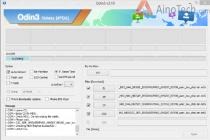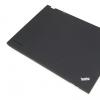Good day to all.
Briefly: in foreign trading platforms so-called engineering samples (ES samples) of INTEL processors have appeared in substantial numbers. These processors are essentially the same i7-6700. Under the cut I'll tell you about the purchase of an ES processor with the QHQG L501639 stepping (aka I7 - 6400T), the pros and cons, and some pitfalls of such a purchase.
We would like to draw your attention to a small note about such a relatively new trend on foreign sites, such as modern-generation Skylake engineering processors. Yes, of course, it was possible to get an engineering sample of a processor abroad before, but what happened this summer and autumn is something new, in terms of the mass scale of the leak. YouTube is already replete with videos about these processors, most often about their gaming power, but few people talk / take pictures about the intricacies of the purchase itself and the choice of a processor among a bunch of names.
As you understood from the kata, these processors are Engineering versions of the full-featured INTEL processors, which, apparently, were used for testing purposes by motherboard manufacturers and are now gradually being stolen and merged by the cunning Chinese.
Let me remind you right away: Engineered versions of processors are the property of Intel and must be sent to the company for recycling after testing. Distribution and use of processors is a violation of the company's rights and is punishable by law.
(ZY in fact, Intel does not always destroy them, and after proper testing, the most extreme versions by date of manufacture are sold to assemblers of finished computers, LENOVO type, HP and DELL)
The characteristics, in a sense, are a lottery, the overclocking potential may differ from stone to stone, but having resigned to such features, you can get a processor of the latest generation twice or three times cheaper than in Russian stores! Everything with it: 4 cores / 8 threads (thanks to Hyper-threading), 8 megabytes of L3 cache, support for all the most modern instructions, etc. The only difference initially (for the considered processor) is in the reduced multiplier and, accordingly, a lower clock frequency.
I will clarify that 6400T these processors were called by the Chinese and in fact there are no limitations inherent in the T-versions of Intel processors (like the even more limited Tjmax), they are not.
I will also briefly point out the differences in the ES models of these processors known to me (from the Internet) from their stepping:
QH8F - the earliest stepping, does not work with an external card, only an inline, in principle, it can be used as an option for office assemblies and HTPC, due to low heat dissipation and rather powerful graphics. processor.
QHQJ - another HTPC candidate, 1.6 GHz and TDP 35w, coupled with Intel's latest generation of integrated graphics, the HD530 - looks very tempting. Still the price is even lower. 🙂
The QHQG reviewed in the review, also known as the i7-6400T, is the most likely candidate for folk stones. Works with an external video card, multiplier 8-24, turbo boost 26, bus overclocking from 3.5 to 4.5 GHz. Full support for all instructions. Stepping is desirable not less than l448.
QHQF - the last revision, before sending "for gold". The multiplier is 8-40, that is, in fact, this is a full-fledged i7-6700. No problems were noticed
Also, briefly about the notorious decoding of the stepping name:

Okay, let's finish with the protracted preamble, and move on to the subject of the review.
The lot was ordered on 11/07/16, sent the next day. The seller sent by mail SPSR, as I asked, the package lasted 10 days, and closer to lunch on 11/18/16 it was given to me by a courier.
Lovers of tracks and other things


The product was packed in a cardboard box, the processor itself was packed in a plastic blister and wrapped in a bubble wrap, the seller put a sachet with cheap thermal paste "for 1 time". I think the seller packed everything quite well.
Pictures of packaging



Here it is, handsome (already installed in the socket):

The seller sent me a version of the processor newer than the one indicated in his photo. On reflection and googling, I realized that the current situation is more into my hands, because what newer version- the less chance of performance problems.
For the processor was purchased ASROCK board Z170 PRO4, as the most successful option in terms of price / quality ratio.
Well, we smear thermal grease (not the one in the kit, of course!
Everything was determined the first time, and the computer will be able to show us everything about the processor.

Processor idle and under load:


Everything does not look as rosy as we would like (although, even in stock, it is more powerful than i3-6100, which is sold in stores in the Russian Federation for the same amount). But all the pulp is in acceleration!
Additional information on the situation with overclocking processors
Those who follow the events on the "iron front" are aware that starting with the Sandy Bridge generation processors - Intel hardware cut overclocking on the bus, which was the bread of overclockers all over the world, leaving only the possibility of overclocking by a multiplier in expensive "K" - versions of their products. Moreover, with the release of the third generation Core, the situation has worsened. Instead of the solder used in Sandy Bridge, Intel began adding r ********************************************************************* order viewer
Now, with the arrival of the Skylake generation, Intel engineers have allocated the bus PCI Express and the chipset into a separate domain, the frequency of which remains fixed regardless of BCLK changes, which was the main problem of overclocking on the bus. But still, the engineers added the so-called BCLK Governor - a mechanism to limit BCLK changes. As it turned out, it was implemented at the software level, which theoretically gave loopholes to bypass it.
What finally happened! The first company to officially implement the loophole was the aforementioned ASROCK, rolling out the SKY OC function - and opening up the ability to overclock any processor of the SKYLAKE generation, but with one limitation - it works (as it was at the beginning) only on Z170 chipsets. Then this feature was picked up by ASUS, MSI and some others.
Intel, of course, did not like this business, and it threatened to remove these functions from the bios, and also promised in the new generation of KabyLake to tackle more tightly limiting the overclocking of BCLK. But it's too late - the bios leaked to the Internet and calmly swing from there. Moreover, craftsmen from Korea were able to correct some shortcomings during acceleration on the bus (such as the blade in some AVX instructions and temperature sensors).
Maud. bios bios and overclocking instructions are taken, for example, here: overclocking.guide/category/intel-oc-guides/skylake-non-k-oc/
In general, for full parity with the I7-6700, we need to help the processor with overclocking according to BCLK. To do this, you need a modified BIOS (on ASUS motherboards, the new BIOSes support everything out of the box, and you can download them on the website), corresponding to your m / n and a little time. Also, after flashing, do not forget to reset the BIOS with a jumper, this is highly recommended.
There are many videos with overclocking instructions on the Internet and on YouTube.
If they ask in the comments, I will post my BIOS settings, which I have tested and are quite successful.
As a result, we get: cons of overclocking:
It's not so scary
1. We are losing all Intel energy saving technologies, including idle frequency and voltage reset. This feature is retained for overclocking above ~ 3.5 GHz, if you do not drive higher, the technologies remain efficient and delight the owners. I want to emphasize that without a load on the processor, it cools down quite quickly and returns to idle temperatures without these technologies, they are only aimed at reducing energy consumption, which is not so important in Russia as in Europe.
2. Increased need for heat dissipation from the processor, according to my estimates, TDP has grown in load from 65w to 100-125w. That is easily solved by an entry-level tower of rubles for 700-1000 with Avito. Well, all the same, the top-end processor, after all, is still smaller than some 8 nuclear stoves from AMD.
As a result: We got a processor similar in power to the top stone from Intel, with support for everything and everything, paying 2.5 times less!
Of course, I cannot recommend this option to everyone, because there is no guarantee compared to the store. But for those who are not afraid to take risks and who are a little versed in the "hardware" - I fully recommend this particular option for an upgrade. But make no mistake take exactly the QHQG stepping l501.
This is my first review, I will accept adequate criticism and requests for points of interest to you on the subject. If everyone likes everything, I will write a similar review about the Intel X3440 processor, which breathes life into socket 1156 (opens video cards up to gtx1060), and can become a good basis for a budget gaming platform PC.
Thank you for the attention.
Good day to all.
Briefly: the so-called Engineering Samples (ES - Engineering Samples) of INTEL processors have appeared on foreign trading floors in large numbers. These processors are, in fact, variations of the Intel i7-6700.
Under the cut I'll tell you about buying an ES processor with QHQG L501639 stepping (aka I7 - 6400T), about the pros and cons, and some pitfalls of such a purchase.
UPD1: Added information on how to preserve CPU power saving functions during overclocking! ( Yes, WE CAN!)
UPD2: At the request of readers, I post a link to ready-made BIOS settings for ASROCK Z170 pro4 (at the end of the review).
We would like to draw your attention to a small note about such a relatively new trend on foreign sites, such as modern-generation Skylake engineering processors. Yes, of course, it was possible to get an engineering sample of a processor abroad before, but what happened this summer and autumn is something new, in terms of the mass scale of the leak. YouTube is already replete with videos about these processors, most often about their gaming power, but few people talk / take pictures about the intricacies of the purchase itself and the choice of a processor among a bunch of names.
Processors, due to the excitement and huge benefits, are quickly sold out. For example, when I ordered a subject, the seller had more than 800 pieces in stock, but now it is no longer in stock.
I will add analogs from other sellers under the spoiler:
More information on INTEL Skylake ES processors
As you understood from the kata, these processors are Engineering versions of the full-featured INTEL processors, which, apparently, were used for testing by motherboard manufacturers and are now gradually being stolen and merged by the cunning Chinese.
Additional Information

Let me remind you right away: Engineered versions of processors are the property of Intel and must be sent to the company for recycling after testing. Distribution and use of processors is a violation of the company's rights and is punishable by law.
(ZY in fact, Intel does not always destroy them, and after proper testing, the most extreme versions by date of manufacture are sold to assemblers of finished computers, such as LENOVO, HP and DELL)
The characteristics, in a sense, are a lottery, the overclocking potential may differ from stone to stone, but having resigned to such features, you can get a processor of the latest generation twice or three times cheaper than in Russian stores! Everything with it: 4 cores / 8 threads (thanks to Hyper-threading), 8 megabytes of L3 cache, support for all the most modern instructions, etc. The only difference initially (for the considered processor) is in the reduced multiplier and, accordingly, a lower clock frequency.
I will clarify that the name 6400T was given to these processors by the Chinese and in fact there are no restrictions inherent in T-versions of Intel processors (like the even more limited Tjmax), they are not.
I will also briefly point out the differences in the ES models of these processors known to me (from the Internet) from their stepping:
QH8F - the earliest stepping, does not work with an external card, only an inline, in principle, it can be used as an option for office assemblies and HTPC, due to low heat dissipation and rather powerful graphics. processor.
QHQJ - another HTPC candidate, 1.6 GHz and TDP 35w, coupled with Intel's latest generation of integrated graphics, the HD530 - looks very tempting. Still the price is even lower. :)
The QHQG reviewed in the review, also known as the i7-6400T, is the most likely candidate for folk stones. Works with an external video card, multiplier 8-24, turbo boost 26, bus overclocking from 3.5 to 4.5 GHz. Full support for all instructions. Stepping is desirable not less than l448.
QHQF - the last revision before being sent "for gold". The multiplier is 8-40, that is, in fact, this is a full-fledged i7-6700. No problems were noticed
Also, briefly about the notorious decoding of the stepping name:
Additional Information

Okay, let's finish with the protracted preamble, and move on to the subject of the review.
The lot was ordered on 11/07/16, sent the next day. The seller sent by mail SPSR, as I asked, the package lasted 10 days, and closer to lunch on 11/18/16 it was given to me by a courier.
Lovers of tracks and other things


The product was packed in a cardboard box, the processor itself was packed in a plastic blister and wrapped in a bubble wrap, the seller put a sachet with cheap thermal paste "for 1 time". I think the seller packed everything quite well.
Pictures of packaging



Here it is, handsome (already installed in the socket):
CPU

The seller sent me a version of the processor newer than the one indicated in his photo. On reflection and googling, I realized that the current situation suits me more, because the newer the version, the less chance of performance problems.
An ASROCK Z170 PRO4 board was purchased for the processor, as the most successful option in terms of price / quality ratio.
briefly the rest of the characteristics of the PC
where the newcomer is installed: Cooler-tower Zalman Cnps11x Performa, 8GB DDR4 Ram Patriot VIPER, KFA2 Gtx 1060 6gb EXOC, SSD 120 KingFast F9
Well, we smear thermal paste (not the one in the kit, of course! :) and preferably something better than KPT-8), put on the cooler, pinch our fingers and start the PC.
Everything was determined the first time, and the computer will be able to show us everything about the processor.

Processor idle and under load:


Everything does not look as rosy as we would like (although, even in stock it is more powerful than i3-6300, which is sold in stores in the Russian Federation for the same amount). But all the pulp is in acceleration!
Additional information on the situation with overclocking processors
In general, for full parity with the I7-6700, we need to help the processor with overclocking according to BCLK. To do this, you need a modified BIOS (on ASUS motherboards, the new BIOSes support everything out of the box, and you can download them on the website), corresponding to your m / n and a little time. Also, after flashing, do not forget to reset the BIOS with a jumper, this is highly recommended.
There are many videos with overclocking instructions on the Internet and on YouTube.
If they ask in the comments, I will post my BIOS settings, which I have tested and are quite successful.
As a result, we get:
Processor after overclocking, as well as temperatures under load and a small benchmark

Cinebench R15 Score

Learn more about the overclocking options:
overclocking up to 4GHz without saving energy saving: 167.7 bus, multiplier 24 (multiplier cache 23), EIST / TurboBOOST / C-states - Disabled. Power supply fixed 1.29 v, LLC - type 1
overclocking to 3.8GHz-Max. frequency while maintaining stability and maintaining energy saving: 158.3 bus, multiplier 24 (multiplier of cache 23), EIST / TurboBOOST / C-states - On, C1E - off. Fixed power supply 1.270 v, LLC - type 1
In both cases, you need to monitor the memory frequency, which, although set to AUTO for most, but grows with increasing bus. I recommend to manually force the default settings for your memory, which can be viewed in the SPD or on a sticker.
Well, already much better! And this is not the limit, because the Internet is full of examples with overclocking to 4.2-4.8 GHz. Productivity, no doubt, has increased. I worked steadily for several days in 24/7 mode - no problems in work, no glitches and BSODs in games. I think this is a good application for stability.
UPD: The processor, as stated, is able to save energy saving technologies at BCLK less than 150MHZ, which I checked at the request of the workers. Having set the bus frequency to 145MHZ with a multiplier of x24 - we have a frequency of 3.5 Ghz and a rather cool processor (after all, the required voltage has also decreased to quite standard 1.184), sacrificing only about 13% of the performance (some figure)!
Tests 3500mhz (24x145Mhz) and Cinebench


Now about cons overclocking:
It's not so scary
1. (24x167.7 = 4Ghz), we are losing all Intel energy saving technologies, including resetting the frequency and voltage to idle. Korean which modified bios m / n to support these processors, approves that this feature is preserved for overclocking above ~ 3.5 GHz (more precisely, up to a BCLK frequency above 150 MHz), and if you do not drive higher, the technologies remain efficient and delight the owners. I plan to test this statement, and will soon supplement the review with results and confirmation / refutation of this statement. Well, the Korean was right, and the processor is capable of save energy saving technologies with BCLK 145MHZ!
I want to emphasize that without a load on the processor, it cools down quite quickly and returns to idle temperatures without these technologies, they are only aimed at reducing energy consumption, which is not so important in Russia as in Europe.
2. When overclocked to the level of i7-6700(24x167.7 = 4Ghz), we have an increased need for heat dissipation from the processor, according to my estimates, TDP has grown in load from 65w to 100-125w. That is easily solved by an entry-level tower of rubles for 700-1000 with Avito. Well, all the same, the top-end processor, after all, is still smaller than some 8 nuclear stoves from AMD.
Which again is not relevant at a frequency below the 150Mhz bus - in this mode, the voltage returns to standard limits, EIST and C-States work, dropping the frequency and voltages as they should be.
As a result: We got a processor similar in power to the top stone from Intel, with support for everything and everything, paying 2.5 times less!
Of course, I cannot recommend this option to everyone, because there is no guarantee compared to the store. But for those who are not afraid to take risks and who are a little versed in the "hardware" - I fully recommend this particular option for an upgrade. But make no mistake take exactly the QHQG stepping l501.
This is my first review, I will accept adequate criticism and requests for points of interest to you on the subject.
If everyone likes everything, I'll write a similar review about the Intel X3440 processor, which breathes life into socket 1156 (opens video cards up to gtx1060), and can become a good basis for a budget PC gaming platform.
Thank you for the attention.
UPD2: At the request of readers, I post a link to ready-made BIOS settings for ASROCK Z170 pro4. Here is a link to google drive: drive.google.com/file/d/0Bw2ZBpGcW0a1Q05Ha1ZPUzZxTms/view?usp=sharing
I hasten to remind you that your RAM may not be able to pull the set settings (2666mhz 15-15-15-35), so when entering the BIOS, adjust the frequency and timings for your memory.
In this form, the Core i7-6400T got to the test lab. There are no complaints about the packaging. The marking corresponds to the order. There are no installation traces. If something is wrong, do not be lazy to argue with the seller. At least get your money back. The manufacturer stuck a label on the processor, on which he indicated the date of shipment - October 13. Then I received a tracking number for the parcel.
Overclocking
We will definitely study the performance of the Core i7-6400T in nominal and overclocked mode, but I’ll say it bluntly: this model is not at all interesting without overclocking. Too much low frequency... The motherboards think they have a Core i7-6700K installed. Therefore, we can safely drive the engineer on the bus. Most importantly, there are no side effects. The AVX instructions work as they should, the temperature sensor does not crash, the embedded video does not turn off. Overclocking the Core i7-6400T requires a Z170 Express motherboard. Checked that everything works on ASUS, ASRock and MSI boards. Problems with GIGABYTE are possible. The stand used ASUS Z170 PRO GAMING (review), GeForce GTX 1080 and 16 GB random access memory DDR4-2133. It is not recommended to use boards with DDR3 (for overclocking).
BIOS version 1301 was installed. This firmware is suitable for overclocking Skylake chips that do not have an unlocked multiplier. With it, the Core i7-6400T worked stably only in default. Any increase in the frequency of the clock generator led to the deadly freeze of the system. I changed DDR4-2133 memory to DDR4-2800, activated the XMP profile - the same result, overclocking failed. Well, I flashed the motherboard BIOS to version 2003 (the most up-to-date at the time of this writing). And then the ice broke. Increasing the BCLK frequency and activating the XMP profile no longer caused the system to “overextend”.
A small note: I'm only interested in stable megahertz. Those in which the Core i7-6400T will work 24/7.
Last year's update of the processor microarchitecture in the person of Intel Skylake did not bring any surprises in terms of productivity growth for desktop solutions, and we got the usual 5-10% superiority over the previous generation. But during the announcement of overclocking models, a very curious moment was noticed: and they received not only an unlocked multiplier, but also the ability to change the frequency of the base clock without losing stability. This fact gave enthusiasts hope for the revival of massive overclocking of processors, which were not initially aimed at the overclocking audience. But the miracle did not happen, and Intel blocked this possibility in conventional models. Fortunately, this limitation turned out to be only at the software level, and in the middle of December the news feeds of technical resources filled with reports that the overclocking of Socket LGA1151 models without the “K” index. This fact has been repeatedly confirmed during our practical acquaintance with the new hardware platform, as you can see for yourself on the pages of our resource.
But at your request, we again decided to return to the very interesting topic of overclocking non-overclocking Intel Skylake processors, devoting a separate material to it. Let's try to summarize all the accumulated information and give practical recommendations for optimizing the system parameters. And the most important thing is to answer whether there is any practical value in all of this, which is especially important, given the not very favorable economic situation in the country. All experiments will be carried out on the example of the model. This processor courtesy of our partner - online store PCshop.ua, where it is possible and buy for about $ 380.
A bit of history

What is overclocking or overclocking? This concept should be understood as a set of methods that allow computer components to operate at frequencies that are higher than the factory ones. The main goal of overclocking is to get the maximum performance out of the available hardware. Now this occupation can be called trivial. Any user can freely buy a suitable motherboard, a processor with an unlocked multiplier and overclock it in a couple of clicks. There is no sense of excitement and satisfaction from the work done. But this was not always the case.
At the dawn of its inception, overclocking was done exclusively by well-trained techies, using a soldering iron, jumpers and other hardware modifications. In short, the whole optimization process boils down to increasing the processor clock frequency, which is the product of two parameters - the multiplier and the base frequency. And since in most cases it is impossible to change the multiplier, you have to operate with the bus values. This became possible due to the fact that models of the same series differ only in frequency. That is, after manufacturing a batch of processors passes a series of tests, according to the worst results of which it is marked. So we get some models with a clock frequency of, for example, 300 MHz, and others - 700 MHz. But not all specimens are so unfortunate. For example, they can be deliberately slowed down due to the need to expand the range of the line, so if you have the necessary knowledge, this annoying injustice can be corrected. At the same time, we get the performance of the older model at a minimum cost. Isn't that wonderful?

In particular, one can recall 1998 and the popular Intel Celeron 300 and Intel Celeron 333 processors. At the recommended prices of $ 150 and $ 192, respectively, they outperformed Intel Pentium II 450 at $ 669 in overclocking. Yes, in this case, the risk of equipment failure increases, but this was in the past and happened through poor cooling, imperfect protection methods and the inability of the user himself to stop there in time. Now the progress has reached such a level that you are unlikely to be able to "burn" the processor.

The release of the first generation of Intel Core processors for Socket LGA775 in 2006 can be considered a truly golden era of overclocking. Overclocking itself has become much more convenient. To do this, it was enough to configure the necessary parameters in the BIOS of the motherboard or just use special utilities under the OS. The younger models Intel Pentium E5xxx and Intel Core 2 Duo E7xxx became the favorites of enthusiasts, which in the right hands bypassed their more expensive brothers Intel Core 2 Duo E8xxx or even Intel Core 2 Quad. By the way, even now, some Intel Core 2 Quad models and their server counterparts Intel Xeon work in system blocks users. Due to the presence of four physical cores and good overclocking potential, they allow you to build game system entry level (by modern standards).

During this period, overclocking is becoming a truly massive phenomenon, and not just a way to save money. It even turns into a sports discipline thanks to the popular HWBOT resource. The essence of the competition is simple - to get the maximum result in benchmarks (3DMark, PCMark, Cinebench, Super PI, etc.) and fix it using the validation process. At the same time, top-end components and extreme cooling methods (phase transition systems, liquid nitrogen and dry ice) are used. This state of affairs was facilitated by the hardware manufacturers themselves, who began to actively produce products specifically designed for overclocking. But this expanse did not last very long. Realizing that overclocking was becoming very popular, Intel decided to make money on it.

The last easily overclocked processors (via the bus) are models for Socket LGA1156 (Intel Nehalem microarchitecture), which were released back in 2009. Subsequent solutions lost this ability (starting with the Intel Sandy Bridge microarchitecture for Socket LGA1155), since the processor reference frequency (BCLK) became rigidly connected to all CPU nodes (processor cores, last-level cache memory, integrated graphics core, ring bus, controller memory, PCI Express and DMI buses). Therefore, even a slight change (above 104-107 MHz) led to unstable system operation.

For enthusiasts, the manufacturer has prepared two overclocking models: and. The processors received unlocked multipliers, through which the clock frequency... But the price of these solutions has also increased in comparison with the conventional versions. That is, if you want to overclock, pay more. A pass to the world of overclocking has become available only for wealthy users and has lost its original meaning.

Yes, you can recall the available dual-core (Socket LGA1150, Intel Haswell microarchitecture) with an unlocked multiplier, but this is an isolated case.
However, with the release of the sixth generation Intel Core, the situation has changed, and now it is possible to overclock non-K-series processors, although it is actively discouraged by the CPU manufacturer. More on this in the next section of our article.
Overclocking Intel Skylake processors without the "K" index in theory

In Intel Skylake processors, engineers have separated the PCI Express bus and the chipset into a separate domain, the frequency of which remains fixed, regardless of BCLK changes.

The base frequency remained rigidly connected only with the internal nodes of the CPU: processor cores, last-level cache memory, integrated graphics core, ring bus and memory controller. Fortunately, the latter work great for increased frequencies... That is, in new platform you can overclock not only by manipulating the multiplier, but also by increasing the BCLK.
This was confirmed by the first acquaintance with overclocking models. But for some reason, Intel blocked overclocking in conventional processors, and even minor changes to the base bus were unsuccessful. The technology was named "BCLK Governor". But, as already mentioned above, the limitation is not of a hardware nature, and it is "treated" at the software level. To do this, just update the motherboard microcode.
The results were not long in coming. Overclocker "Dhenzjhen" overclocked Intel Core i3-6320 processor with locked multiplier from 3.9 GHz nominal to 4.955 GHz... To do this, he used a SuperMicro C7H170-M motherboard with a special BIOS version. Soon, other manufacturers released updated BIOS versions, but only for motherboards based on the flagship chipset. The solutions were not, and remained deprived, although, apparently, there should not be any obstacles to this. Most likely, the manufacturers decided to spur sales of only more expensive models, which is a pity. It is noteworthy that only ASRock posted special versions of the microcode on its official website. The rest of the vendors - ASUS, BIOSTAR, GIGABYTE, EVGA and MSI - are distributing them through overclocking forums, fearing a negative reaction from Intel. As it turned out, there were reasons for this. And soon the company was reluctant to allow overclocking of conventional Intel Skylake processors. Despite this, you can still find the necessary BIOS versions on the network, which continue to appear with fixes and additions. So there is complete order.
But not everything is as simple as it seems at first glance. And when overclocking neo-overclocking processors over the bus, a number of nuances and limitations arise:
- Energy-saving technologies stop working, and the processor always operates at the maximum frequency with the maximum supply voltage. Intel Turbo Boost Technology also becomes inactive.
- Temperature monitoring of processor cores starts to produce incorrect data.
- The graphics core integrated into the processor is disabled.
- The execution speed of AVX / AVX2 instructions is reduced several times.
However, do not get upset prematurely. Experienced overclockers already recommend disabling all additional technologies: Intel Turbo Boost, Intel Enhanced SpeedStep and C-states, as any fluctuations in the multiplier and voltage can negatively affect the stability of the system during overclocking. Temperature monitoring can be performed using the CPU Package sensor, for example, using the HWiNFO utility. Disabling the embedded video will not upset anyone, since most overclockers have a discrete graphics card.
The only really unpleasant moment is the drop in the execution speed of AVX / AVX2 instructions. And this is very strange, considering that overclocking models are devoid of this drawback and perfectly overclock on the bus. And in fact, they are no different from the usual ones, except for an unlocked multiplier and a slightly higher frequency. We can assume that this is again a software limitation. Mainly AVX / AVX2 are used in application programs such as video coding, 3D modeling and some graphic editor... Most everyday programs, including games, hardly use AVX instructions. The exceptions are GRID Autosport and DiRT Showdown, but as practice shows, there is nothing critical about that. Suffice it to recall the processor, which generally lacks support for vector instructions, but this does not prevent its owners from playing modern games.
Preparing for overclocking by BCLK
As you can already understand from the above, absolutely all processors of the Intel Skylake generation are suitable for bus overclocking: from Intel Celeron to Intel Core i7. But of the greatest practical interest are the younger models of each line, since at the minimum price, overclocking allows them to easily overtake and even bypass the more expensive older brothers in terms of performance. You can see for yourself in the reviews and . For clarity, we present a list of the most interesting overclocking models in the form of a pivot table:
|
Model name |
Number of cores / threads |
Base / dynamic frequency, MHz |
Factor |
||
But besides a suitable processor, you need a motherboard based on the Intel Z170 chipset. In our case, there will be three of them:, and ASUS Z170-P. Why is this done? Let's try to use their example to find out whether we can get a decent overclocking on affordable boards, or if we still need specialized solutions. And we will not overclock the simplest processor - Intel Core i7-6700. If the motherboards cope with it, then with some Intel Core i3 and even more so. Before starting experiments, you need to find the necessary BIOS for your motherboard and flash it. To do this, we looked at HWBOT in the appropriate section of the forum.



Now you can go directly to the preparatory settings.
- First, go to the UEFI BIOS and in the "Advanced \ CPU Configuration" section, set the "Boot Performance Mode" option to "Turbo Performance", and in the "CPU Power Management Configuration" subsection, turn off "Intel Turbo Boost", "Intel Enhanced SpeedStep" and C-states by choosing “Disabled”.
- Next, go to the "Extreme Tweaker" or "Ai Tweaker" section (depending on the motherboard manufacturer, the names may be different) and switch the "Ai Overclock Tuner" option to the "Manual" mode. In this case, we will have full access to change all parameters at our own discretion.
- Next, we fix the maximum multiplier of all processor cores in the "1-Core Ratio Limit" item.
- So that the RAM does not become a limitation during overclocking, using the "DRAM Frequency" item, we set its frequency to several points lower than the nominal, since when the bus changes, its frequency will also increase.
For all settings Motherboard BIOS boards can be seen in the video below:
BIOS setup ASUS MAXIMUS VIII RANGER for Intel overclocking Core i7-6700
BIOS setup ASUS Z170-P D3 for overclocking Intel Core i7-6700
BIOS setup ASUS Z170-P for overclocking Intel Core i7-6700
Now you can start directly overclocking the Intel Skylake non-K processor. The process itself is quite simple and boils down to increasing the bus frequency (BCLK Frequency) and gradually increasing the voltage supplied to the processor (CPU Core Voltage Override).
How to choose the right frequency? Recall that the processor frequency is calculated using the formula:
CPU Freq = CPU Ratio × CPU Cores Base Freq
Let's say we want our Intel Core i7-6700 with a multiplier of "x34" to run at 4400 MHz. To do this, we divide 4400/34 and get the BCLK equal to 129 MHz. The same rule applies to other processors. For convenience, we present the BCLK value to achieve typical frequencies of 4500 - 4700 MHz for the previously considered processors:
|
Model name |
BCLK frequency, MHz |
Factor |
Clock frequency, MHz |
|
Intel Pentium G4400 |
|||
|
Intel Core i3-6100 |
|||
|
Intel Core i3-6300 |
|||
|
Intel Core i5-6400 |
|||
|
Intel Core i7-6700 |
In this case, you need to monitor the temperature and check the stability of the system after overclocking.
Let's take a closer look at the allowable voltage and temperature values. Experienced overclockers consider the 1.4-1.45 V threshold safe for everyday use. attention to three more important parameters:
- CPU VCCIO Voltage (VCCIO) - the voltage on the memory controller built into the processor. It is recommended not to exceed 1.10 V.
- CPU System Agent Voltage (VCCSA) - the voltage on the system agent and other controllers built into the processor. It is recommended not to exceed 1.20 V.
- DRAM Voltage (Vdram) - supply voltage on RAM modules. Values up to 1.4 V can be considered conditionally safe.
For a more detailed acquaintance with the capabilities of each option, we suggest visiting ours.
Now about the temperature. If Intel specifies T CASE = 71 ° C, this means that the maximum allowable temperature in the integrated heat spreader (IHS) of the processor, which can only be measured by an external sensor, reaches 71 ° C. The mechanism for skipping clock cycles (throttling) turns on when it reaches 100 ° C according to the data of the internal sensors of the cores. Therefore, roughly speaking, the T CASE index at the level of 71 ° C can be considered equivalent to 100 ° C of the internal sensors of the nuclei.
Overclocking and testing
The following list of equipment was used for the experiments:
|
CPU |
Intel Core i7-6700 (Socket LGA1151, 4.0 GHz, L3 8MB) |
|
motherboards |
ASUS MAXIMUS VIII RANGER (Intel Z170, Socket LGA1151, DDR4, ATX) ASUS Z170-P (Intel Z170, Socket LGA1151, DDR4, ATX) ASUS Z170-P D3 (Intel Z170, Socket LGA1151, DDR3, ATX) |
|
RAM |
2 x 8 GB DDR4-2400 HyperX Fury HX424C15FBK2 / 16 2 x 8 GB DDR3L-1600 HyperX Fury HX316LC10FBK2 / 16 |
|
Video card |
ASUS GeForce GTX 980 Matrix Platinum (4GB GDDR5) |
|
HDD |
Seagate Enterprise Capacity 3.5 HDD v4 (ST6000NM0024) 6TB SATA 6Gb / s |
|
Power Supply |
Seasonic X-560 Gold (SS-560KM Active PFC) |
|
Philips Brilliance 240P4QPYNS |
|
|
Video capture device |
AVerMedia Live Gamer Portable |
|
Operating system |
Microsoft Windows 8.1 64-bit |


The Intel Core i7-6700 test processor has a "batch code" L542B978 - 96000, which contains information about the place, date and production batch. In our case, it was produced in week 42 of 2015 (between October 12 and 18) in Malaysia with batch number 96000.
Acceleration was carried out on motherboards ASUS MAXIMUS VIII RANGER, ASUS Z170-P D3 andASUS Z170-P in three modes:
- Without raising the tension.
- Intermediate overclocking with a slight rise in voltage for stable operation at 4400 MHz.
- The most stable overclocking.
The voltage of 1.095 volts in the BIOS (according to monitoring data 1.104 V) is taken as nominal, since the boards independently set it at maximum load in full automatic mode... We checked the stability by passing the benchmark and a 15-minute stress test in RealBench 2.41. This time is quite enough to determine stability. In this case, the heating was one of the highest, which is unlikely to be achieved under real conditions of use. By the way, classical stress tests like Linpack or Prime95 are not suitable for this role, since they actively use AVX instructions, which slow down when overclocking non-overclocked processors and cannot recreate the maximum load. Monitoring was carried out using the HWiNFO and CPU-Z utilities.

The first to go into battle was the ASUS MAXIMUS VIII RANGER gaming board with excellent overclocking capabilities. At voltage 1 , 104 V and manually raising the reference frequency to 121 MHz, the speed of the Intel Core i7-6700 was brought to 4113.86 MHz, which is an increase of 21% relative to the nominal.

At the same time, the power consumption of the system increased insignificantly: from 51 W in idle (all energy-saving technologies are activated) and 223 W under stress load to 61 W and 230 W, respectively. The maximum temperature under stress did not rise above 51˚C.

On ASUS Z170-P D3, it turned out to achieve 4107.23 MHz with the same 1 , 104 V and a BCLK value of 121 MHz.

Power consumption has increased from 48W and 223W to 62W and 230W, respectively. The maximum temperature did not rise above 53˚C.

ASUS Z170-P obeyed a slightly lower processor frequency, namely 4060.70 MHz at voltage 1 , 104 V and a BCLK value of 119.5 MHz.

In this operating mode, power consumption has increased from 48 W and 225 W to 59 W and 230 W, respectively. The temperature did not rise above 52˚C.

To accelerate the Intel Core i7-6700 to 4400 MHz on the ASUS MAXIMUS VIII RANGER, it was necessary to raise the base frequency to 129.5 MHz, and the voltage to 1.215 V, although, judging by the readings of the utilities, at times it reached 1.232 V. The frequency increase was 29 , 4% of the nominal value.

The power consumption figures were 64W idle and 240W under load - still fairly modest values. The temperature is kept in the range of 60-64 ˚C.

For a stable Intel work Core i7-6700 at 4400 MHz on ASUS Z170-P D3 needed to set a slightly higher voltage - 1.230 V (according to monitoring data - up to 1.248 V).

Power consumption was at 63W and 249W, respectively, and temperatures were at 70˚C.

On ASUS Z170-P for 4400 MHz, it was required to raise the voltage to 1.215 V (according to monitoring data - up to 1.232 V).

At the same time, power consumption was 63 W and 265 W in idle and load, respectively. The maximum temperature did not rise above 63˚C.
Let's move on to the most interesting part - maximum overclocking.

On ASUS MAXIMUS VIII RANGER, it turned out to achieve a frequency of 4708.22 MHz with an increase in BCLK to 138.5 MHz. As a result, we got a 38% increase to the nominal frequency. At the same time, the voltage was increased to 1.415 V (1.472 V according to monitoring data), and to compensate for its drawdowns in BIOS settings the Load Line Calibration (LLC) parameter has been set to LEVEL -6.

At the same time, the power consumption of the processor increased to 74 W and 322 W in idle and load, respectively, and the processor itself warmed up under stress load up to 98˚C.

The maximum stable frequency on the ASUS Z170-P D3 was 4523 MHz when the reference frequency was raised to 133 MHz. The increase was 33% against the nominal value. To do this, we had to raise the supply voltage to 1.415 V (1.408 V according to the monitoring data) and set the “LLC” value to “LEVEL -5”.

In this mode, power consumption has increased to 71 W and 310 W, respectively. Under stress, the temperature did not exceed 85˚C.

On the ASUS Z170-P, we made the processor run stably at 4691 MHz with a BCLK of 138 MHz. In this case, it was necessary to raise the voltage to 1.415 V, and set "LLC" to "LEVEL -6".

In this mode, power consumption was 73 W and 325 W, respectively, and the temperature at peak load reached 96˚C.
For a visual assessment of the obtained overclocking results, we suggest taking a look at the summary table:
|
ASUS MAXIMUS VIII RANGER |
|||||||||
|
Overclocking Intel Core i7-6700 |
|||||||||
|
Processor frequency, MHz |
|||||||||
|
BCLK frequency, MHz |
|||||||||
|
CPU voltage, V |
|||||||||
|
Power consumption of the entire system idle / load, W |
|||||||||
|
Maximum temperature, ˚C |
|||||||||
Analyzing the results of overclocking Intel Core i7-6700, we can safely say that all tested motherboards coped with the task. True, some are better, and some are a little worse. If you want uncompromising overclocking, then a solution of the level of ASUS MAXIMUS VIII RANGER may well give it. In this case, all thanks to the enhanced 10-phase digital power subsystem, which perfectly copes with its direct duties at any type of load and at the highest voltages, without a hint of drawdowns. The board clearly has a large margin of safety for extreme overclocking. However, it is quite possible for economical users to recommend solutions like ASUS Z170-P or ASUS Z170-P D3. For example, these boards also have a 7-phase digital power system, good cooling and wide customization options. That is, they have everything you need to get a decent overclocking. The main thing is to take care of a good cooling system. But you should also understand that overclocking is a lottery. It is not a fact that your processor will be able to repeat the achieved performance. Fortunately, all Intel Skylake models that have visited our laboratory have conquered the 4.6 GHz mark. So, on the other hand, you may be more fortunate than ours.
In conclusion, we propose to take a look at the results of RealBench v.2.41 at the maximum frequency of Intel Core i7-6700

The places were distributed according to the obtained maximum processor frequency: ASUS MAXIMUS VIII RANGER, ASUS Z170-P and ASUS Z170-P D3. On average, the increase in productivity was about 24% relative to the nominal.
Energy consumption
Overclocking Intel Core i7-6700 pleased us pleasantly, but let's estimate how much its power consumption has grown after such optimizations. To do this, we will use the results obtained on the motherboard ASUS board MAXIMUS VIII RANGER.

Looking at the graph, you can see that while the voltage on the processor remains unchanged, the increase in power consumption is linear with increasing frequency. But as soon as we significantly increase the voltage on the processor, a sharp jump in consumption is observed. As a result, the power consumption of the Intel Core i7-6700 at maximum overclocking increased by 100 W in comparison with the nominal. This is the price to pay for increased productivity. This should be taken into account when conducting experiments and take care of a high-quality power supply.
Analysis of the practical benefits of overclocking
Let's say you want to build a mid-range computer. What is the best choice? The processor is simpler and the components for overclocking or the processor is more powerful, and the components are cheaper. Let's try to figure it out.
|
CPU |
Intel Core i3-6100 tray - $ 127 (3175 UAH) |
Intel Core i5-6400 BOX - $ 199 (4986 UAH) |
|
Motherboard |
||
|
DeepcoolGAMMAXX 300 - $ 23 (584 UAH) |
||
|
Power Supply |
||
|
total amount |
$ 349 (8712 UAH) |
$ 345 (8612 UAH) |
As you can see, the assemblies turned out to be almost the same in price. But thanks to overclocking to 4.5 - 4.7 GHz, the Intel Core i3-6100 bypasses the Intel Core i5-6400 by 3-5%, depending on the type of load. In fairness, it should be noted that 3-5% includes not only gaming applications, but also specialized ones (rendering, mathematical calculations, coding, and so on). But if you take a computer exclusively for games, then an overclocked Intel Core i3-6100 can produce FPS, comparable to the configuration on an Intel Core i5-6600 operating at par. In addition, no one bothers you to save money on the power supply and the motherboard. In the first case, everything depends on the appetite of your video card, and in the second - on the required functionality and loyalty to a particular manufacturer. In this case, the profit can be much more significant.
What is the situation in the higher price range? Let's take a look at such an assembly.
|
CPU |
Intel Core i5-6400 tray - $ 192 (4785 UAH) |
Intel Core i5-6600 BOX - $ 239 (5969 UAH) |
|
Motherboard |
ASUS Z170-P - $ 141 (3518 UAH) |
MSI B150M MORTAR - $ 96 (2400 UAH) |
|
ZALMAN CNPS10X Performa - $ 34 (855 UAH) |
||
|
Power Supply |
Aerocool KCAS-600 - $ 58 (1455 UAH) |
Aerocool KCAS-500 - $ 50 (1257 UAH) |
|
total amount |
$ 425 (10609 UAH) |
$ 385 (9610 UAH) |
As a result, we get 10% more expensive and 5% slower to build an Intel Core i5-6400 compared to an Intel Core i5-6600. But if you overclock the Intel Core i5-6400, then it already bypasses the older brother by 10-15% and even approaches the much more expensive Intel Core i7-6700 ($ 369 or 9207 UAH). This can be seen on the example of testing. In this case, overclocking is fully justified, especially if you initially looked to the side. The difference in price between them is $ 71 (UAH 1772). And the money saved can be reported to a more efficient video card or directed to other needs.
Let's say a few words about the Intel Core i7-6700. The difference between it and the Intel Core i7-6700K is about $ 31 (778 UAH), but both of them are excellent overclocking. It is unlikely that you will be able to achieve much savings, but as always, the choice is yours.
conclusions
Summing up the material, we have two news for you: good and bad. Let's start with the bad one. If you work with specialized programs like video encoding, 3D modeling and the like that use AVX / AVX2 instructions, then overclocking non-overclocking Intel Skylake processors is contraindicated for you. This is because in this case, the speed of execution of these very instructions decreases and, as a result, a drop in overall performance is observed. If you still need to get more performance, and you plan to overclock the processor, then the choice remains only between Intel Corei5 - 6600K and Intel Core i7-6700K.
Now for the good news. In all other cases, overclocking is not only possible, but also necessary - especially in game assemblies. The same Intel Core i3-6100 in overclocking can give out comparable performance with full-fledged 4-cores working at par. And the younger Intel Core i5-6400 not only bypasses the older brothers in the line, but can even come close to the Intel Core i7-6700. At the same time, for a decent overclocking (most Intel Skylake processors easily take the 4.5-4.6 GHz line), it is not necessary to buy an expensive top-end motherboard, but you can get by with affordable models. The main thing is to take care of good cooling and a high-quality power supply.
| Subscribe to our channels | |||||
The progress that Intel processors undergo as microarchitecture generations change, in recent times slowed down significantly. Indeed, if we compare with each other processors similar in positioning of the next years of release, it turns out that their computing performance differs at best by 3-7 percent, and this despite the fact that the developers are constantly talking about huge steps (“ticks” and “ takah ") in the development of microarchitecture. Therefore, it is not surprising that many owners of systems even five years ago simply do not see the point in upgrading their computers and continue to stay with Sandy Bridge, sincerely believing that in the absence of real competition, the development of desktop processors has seriously slowed down.
However, in reality, everything is far from so unambiguous. We will not argue with the thesis about the absence of a noticeable increase in performance. But it is impossible to agree with the fact that nothing interesting has been happening in the development of desktop systems for a long time. And this is not at all about embedded in processors graphics core and not about the introduction of new interfaces into modern platforms, but about the fact that over the past couple of years Intel has come a long way towards returning overclocking to its original meaning.
With the transfer of processors to the Core architecture, Intel tried to turn the idea of overclocking processors, making it not a means of saving the budget, but, on the contrary, a very expensive sport. And partly Intel (with the active assistance of the rest of the industry) succeeded: processors capable of overclocking became noticeably fewer, and their cost became noticeably more expensive. However, mass practical overclocking, fortunately, has not disappeared. In part, it was fueled by the efforts of AMD, and sometimes some gifts (for example, Pentium Anniversary Edition) were presented by Intel itself. But the most important event for the overclocking renaissance happened quite recently - with the advent of the LGA1151 platform and the sixth generation Core processors.
The fact is that, as it suddenly turned out, any processors in the LGA1151 ecosystem can be overclocked: both specially designed models with the K index in the name, and all the other Skylakes with a locked multiplication factor. Yes, overclocking of ordinary processors is not as straightforward as that of expensive K-versions. It is performed not by changing the multiplier, but by increasing the frequency of the base clock. Therefore, not all motherboards are suitable for such overclocking, special BIOS versions are needed, and, in addition, AVX / AVX2 instructions are disabled as a side effect. Nevertheless, the results are quite positive: in a number of applications - primarily of a gaming nature - you can get a noticeable increase in performance.
Of course, we can say that Intel has no direct relation to the revival of mass overclocking, because the company still does not give freedom, but tries to impose restrictions on overclocking Skylake models without the K index by organizational measures. But firstly, it does not really succeed in the fight against overclocking of mass processors, and open loopholes, one way or another, have not gone anywhere. And secondly, who, if not Intel, laid the hardware foundation for such overclocking? This whole story became a reality solely due to the fact that the LGA1151 platform has the ability to use two clock generators at once: one for the processor frequency, and the second for shaping the interface frequencies. Before the advent of Skylake, such a division of frequencies was not included in the design of platforms, and therefore it was simply impossible to overclock processors in any other way than by changing their multipliers. In other words, Intel is directly involved in the return of overclocking of inexpensive processors, and it would be unfair to deny its role in this.

But the most compelling evidence that Intel was seriously considering opening up complete overclocking freedom in Skylake recently came from China. Pre-release Skylake generation processors, which are freely overclocked by the clock generator frequency, without any tricks or restrictions, began to be actively sold on numerous Chinese trading platforms. That is, the overclocking lock for non-K-processors was added by the microprocessor giant just before the launch of Skylake on the market, and it is not surprising that such artificial prohibitions were eventually circumvented.
This whole story is not only about the fact that, they say, Intel wanted to add overclocking to Skylake, and then changed its mind, but cunning motherboard manufacturers were able to implement Intel's original plan without the participation of the microprocessor giant. It adds to the already well-known picture of Skylake overclocking one more important touch: in nature there are pre-release LGA1151 processors, which, by increasing the clock generator frequency, are able to overclock "out of the box", without any additional conditions. And this fact is of great practical value, since these processors can be obtained if desired, and at a very attractive price.

Actually, this article will be devoted to the story of testing such an easily overclocked pre-release processor. Recently, computer forums have been overwhelmed with an avalanche of enthusiastic reviews from users who purchase low-frequency engineering samples of quad-core Skylake on Chinese Internet sites and raise their frequency to the level of Core i7-6700K.
It is not very easy to believe that this is possible, since the Chinese sell such processors about two to two and a half times cheaper than a full-fledged modern quad-core processor of the Core i7 level. Therefore, we decided to figure it out ourselves and ordered on Aliexpress one of the processors with the mysterious and non-existent in Intel's understanding of the name Core i7-6400T, for which sellers from the Middle Kingdom promise the possibility of easy overclocking and operation at a frequency of about 4.0 GHz.
Since the multiplier of the vast majority of engineering processors is locked, they have to be overclocked at the base frequency. In the case of Skylake, this is quite possible on motherboards that have an external clock generator, and these are practically any motherboards based on the Intel Z170 chipset. If we were talking about overclocking serial processors, then a special, corrected BIOS would also be required for success. But for overclocking the pre-production Skylake samples of stepping A0 and Q0, it is not needed - such processors are freely overclocked in frequency and on regular firmware versions. This means that it is not so difficult to raise the frequency of the Core i7-6400T. And even more than that, the engineering versions of the Skylake stepping Q0 compare favorably with their later serial counterparts in that when overclocking the clock generator frequency, temperature sensors and AVX / AVX2 instructions are not disabled in them. That is, the overclocking is even more complete.
When overclocking Skylake in frequency, there are two subtleties: Enhanced technology Intel SpeedStep must be forcibly disabled and the Boot Performance Mode must be set to Turbo Performance. These settings in most cases eliminate cold start problems. Otherwise, the algorithm is very simple: the processor multiplier is fixed at the maximum allowable value, after which the frequency of the base clock generator BCLK is increased and, if necessary, the processor voltage is added to ensure stability. Do not just forget that the memory frequency is also associated with BCLK, therefore, when overclocking with the base clock generator, along the way, it is necessary to adjust the multipliers responsible for the formation of the DDR4 SDRAM frequency.
The overclocking of the engineering Skylake Q0 stepping occurs precisely according to this algorithm, but one should not expect the same overclocking results from them as are obtained on serial processors. Q0 stepping is preliminary, and maximum frequency, at which its carriers are capable of working, lies in the vicinity of the 4 GHz mark.
In the process of studying the capabilities of our Core i7-6400T QHQG instance, we plotted the dependence of its maximum frequency on the level of the applied voltage. The graph below clearly shows that the frequency potential of the engineering Skylake is really worse than that of serial processors, but the point is not in some artificial limitations, but in the very design of the Q0 stepping core.

The nominal voltage of the tested Skylake is 1.12 V, but we started the overclocking experiments with a lower value of 1.0 V. And as practical tests have shown, even in this case, the engineering Core i7-6400T quietly takes the 3 GHz bar. However, you should not be deluded especially. Increasing the voltage does not push the stable overclocking limit too far, but the operating temperatures rise very steeply.
As a result, an increase of 0.4 V to the starting voltage made it possible to push the cutoff frequency only by 850 MHz. And the maximum result that we managed to squeeze out of our Core i7-6400T QHQG was only 3.9 GHz. Attempts to further increase the frequency had to be discarded due to excessive heating of the processor crystal in stability tests in LinX 0.7.0, even though all experiments were carried out with a fairly good Noctua NH-U14S cooler.

As you can see in the screenshot above, the overclocking was carried out with the multiplication factor set to 24x. This is the maximum turbo multiplier at which the processor under study can work with a load on all cores at once. The BCLK frequency was raised to 162.5 GHz, which eventually brought the Core i7-6400T to the 3.9 GHz mark. However, in order to be able to carry out a full cycle of stability tests in this state, the Vcore voltage had to be increased to 1.425 V. And this led to almost critical heating - throttling in engineering Skylake is activated at 100 degrees, like in regular Core i7s.
It is obvious that, as in serial processors, engineering samples also use a polymer thermal interface, and clearly not of the best quality. But for a processor with a nominal frequency of 2.2 GHz, this is not surprising. However, keep in mind that better overclocking of the Core i7-6400T can be achieved with scalping.
At first glance, Skylake's overclocking to 3.9GHz doesn't seem like much of an overclocking success. However, do not forget that we are talking about preliminary stepping and about a processor whose nominal frequency was 1.8 times lower than the achieved overclocking. Therefore, the result obtained is actually not so bad. In the end, taking for the experiment a processor costing about $ 130- $ 150, in the end we came to the frequency that 300-dollar CPUs provide. And this, generally speaking, is not at all an illusory gain.
Besides, any overclocking is always a lottery. And with another instance of the Core i7-6400T, the result could have been completely different. For example, on the Web, you can find a lot of reviews indicating that engineering CPUs have conquered the 4-gigahertz mark or even about the possibility of stable operation at frequencies of about 4.2 GHz. In other words, the Core i7-6400T is quite a worthy object of exertion for the economical overclocker.
As for our particular case, we managed to overclock without any special efforts and without the tedious selection of secondary parameters. Only a single V CORE voltage was changed, and in general, a set of applied settings can be found in the following screenshot.

Overclocking was performed on the ASUS Maximus VIII Ranger board, but this has no of great importance... In a similar way, Chinese engineering processors are overclocked on other motherboards. However, in some cases, you may encounter disabling AVX / AVX2 instructions and temperature monitoring, for example, this happens on some motherboards from ASRock. But in this case, BIOS versions modified by enthusiasts can come to the rescue, which are regularly posted on the Korean website.














